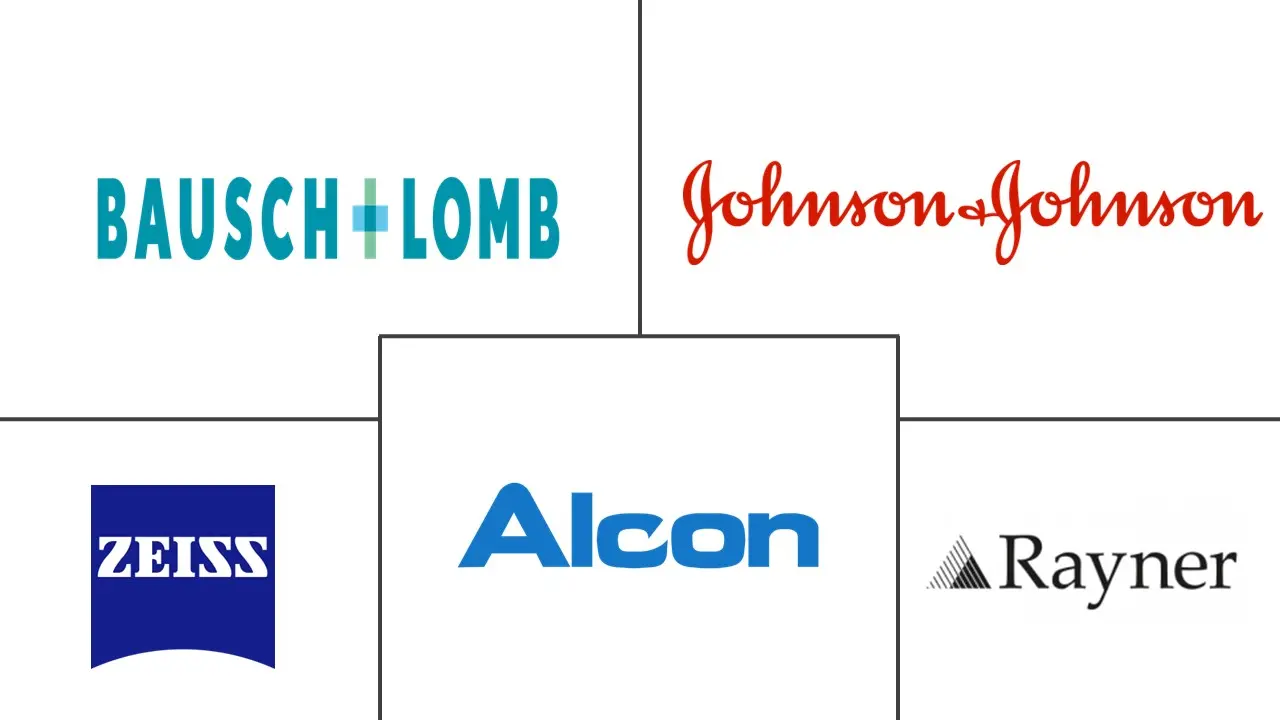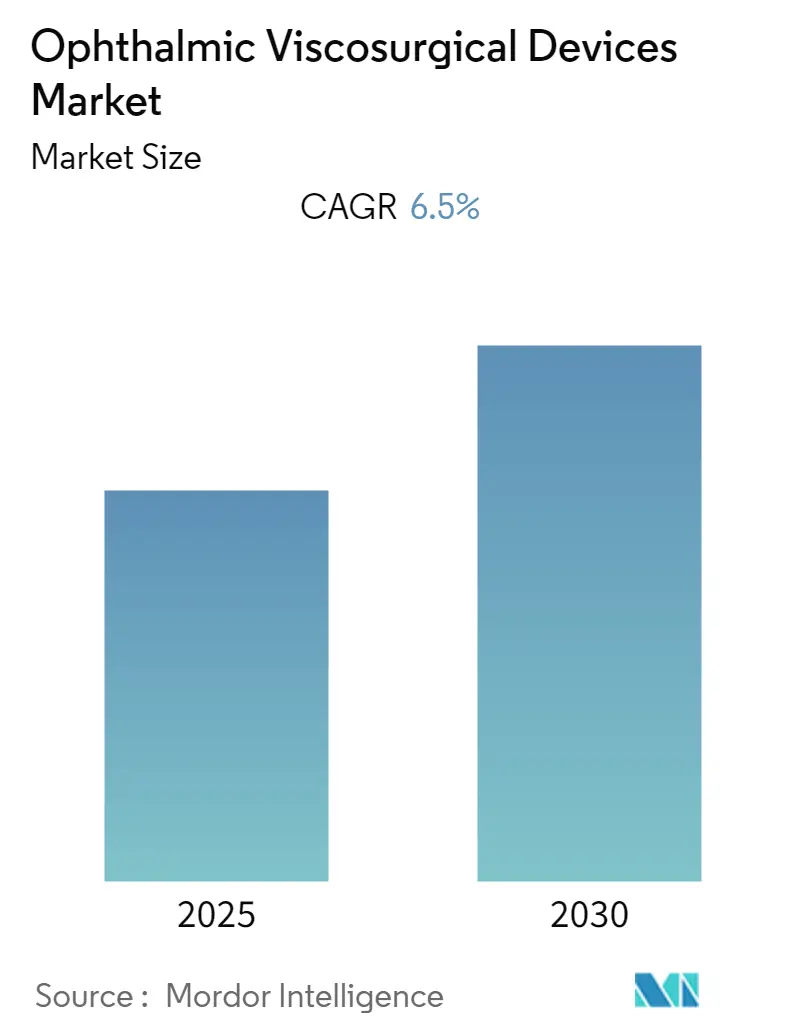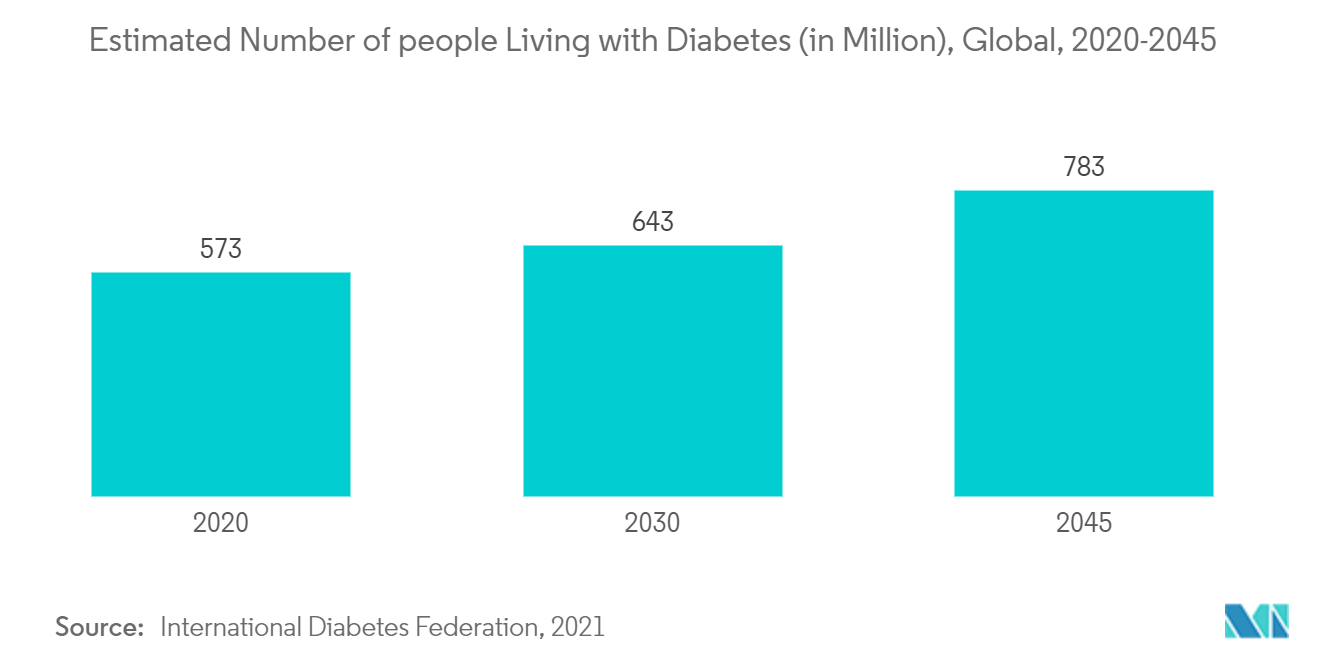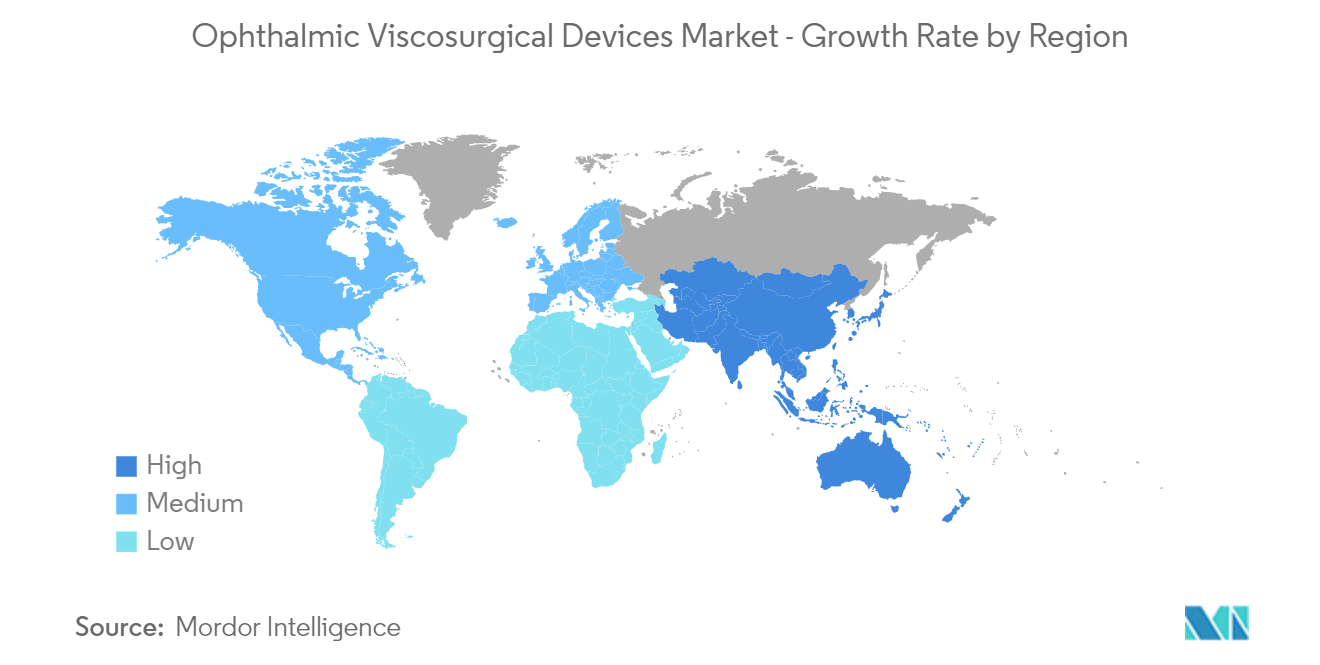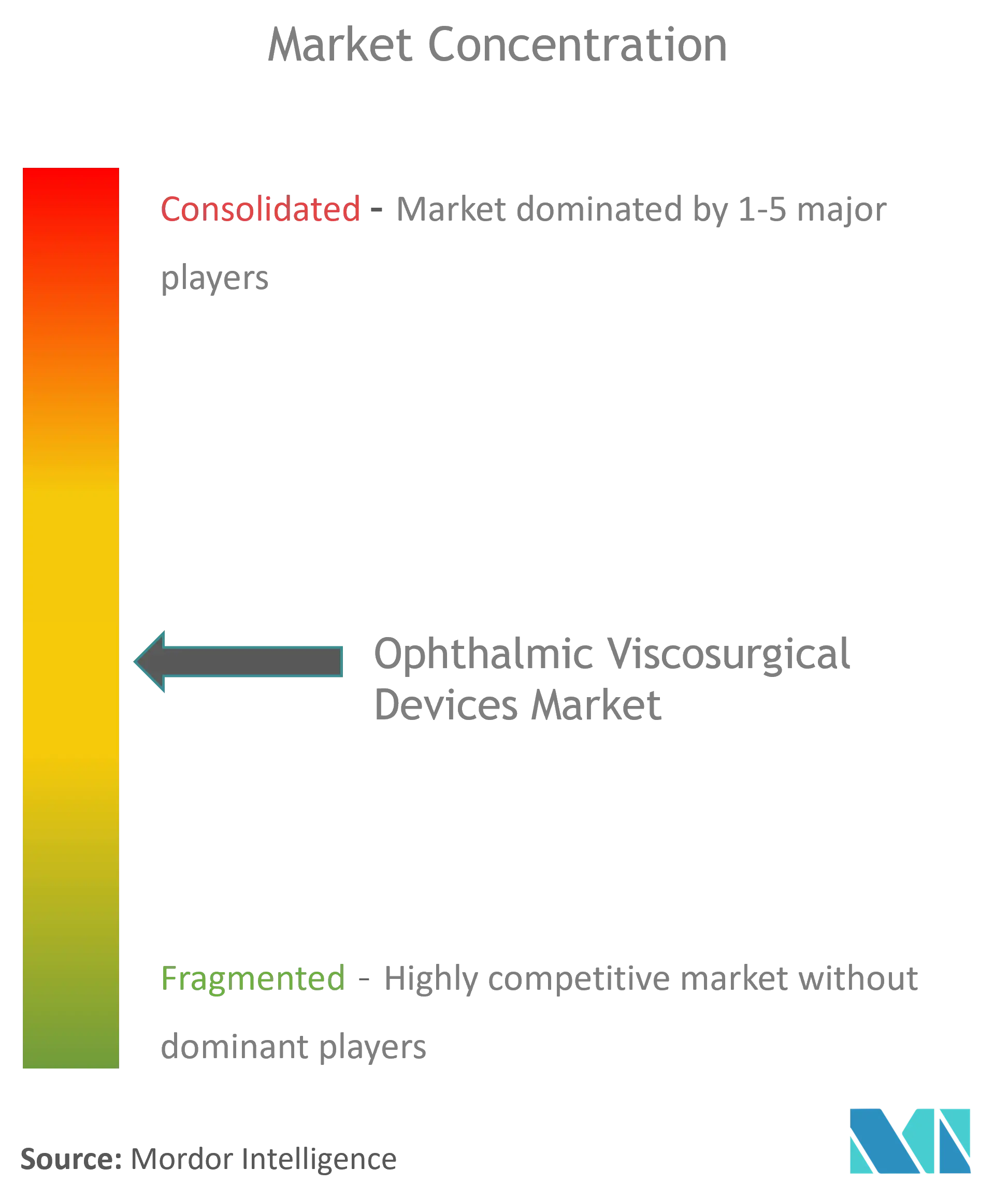Ophthalmic Viscosurgical Devices Market Analysis
The Ophthalmic Viscosurgical Devices Market is expected to register a CAGR of 6.5% during the forecast period.
Initially, with the increasing COVID-19 cases around the world, governments around the globe implemented lockdown measures to stop the spread of the SARS-CoV-2 virus, which not only led to a drop in footfall in clinics and hospitals for eye care but also led to the cancellation or postponement of many procedures which had its impact on the patients as well as the studied market. For instance, according to a research study published by Parul C Gupta et al. in 2021 in the Indian Journal of Ophthalmology, the studied clinic was expected to perform 7,500 cataract procedures. Still, due to the pandemic, they could serve only 2,500 procedures. This data suggested a significant decrease in cataract procedures during the COVID-19 pandemic. As per the research study published by Gabriel Ayubet. al., in November 2021, on the comparison of the pre-pandemic and pandemic periods data for glaucoma patients in a tertiary center, it was observed the total number of outpatient clinical visits, visual field exams, surgical procedures, and medications released decreased by 92.52%, 93.84%, 72.74%, and 19.63%, respectively. This data shows a negative impact of COVID-19 on diagnosing and treating ocular disorders; thus, the market suffered negatively. Moreover, the market has been making a strong comeback since the limitations were lifted and normalized the supply chain. Increased outpatient visits and the removal of all restrictions on ophthalmic procedures have been driving the market recovery over the projected period.
This is attributed to the rapidly increasing geriatric population, increasing prevalence of diabetes, and an increasing number of cataract and glaucoma surgeries performed. The rising geriatric population worldwide is more prone to ocular disorders. For instance, the data published in October 2021 by the World Health Organization (WHO) reported that the pace of population aging is much faster than in the past, and by 2030, 1 in 6 people in the world will be aged 60 years or over. The share of the population aged 60 years and over will increase from 1 billion in 2020 to 1.4 billion by 2030. Thus, an increase in the geriatric population is expected to boost market growth over the forecast period.
Diabetes can damage the eyes, resulting in vision problems or even blindness. People with diabetes may experience various eye issues known as diabetic eye disease. These ailments include glaucoma, cataracts, diabetic macular, and diabetic retinopathy, and thus growing prevalence of diabetes is expected to cause eye diseases, thereby boosting the market growth. For instance, according to the IDF Diabetes Atlas Tenth Edition 2021, diabetes has affected around 537 million persons (20-79 years) in 2021 across the world. Diabetes is expected to affect 643 million people by 2030 and 783 million by 2045. Thus, the increasing prevalence of diabetes, the most common cause of ophthalmic disease, is expected to boost the market over the forecast period.
However, the availability of alternative procedures may hamper the market growth.
Ophthalmic Viscosurgical Devices Market Trends
Cataract Surgery Segment is Estimated to Witness Healthy Growth
The significant factors expected to drive growth in the cataract surgery segment are the increasing prevalence of cataracts and the growing geriatric population globally. For instance, according to the research study published in Sage Journal in January 2021, there were between 3,000 and 10,000 new cases per million inhabitants in East Africa in 2020. With more than 0. 5 million cases of blindness and 1. 2 million cases of severe visual impairment, cataract was the primary reason for preventable blindness and impaired vision in Ethiopia. A cataract is the second-leading cause of impaired vision in persons of all ages, accounting for 50% of all cases of blindness and 33% of all cases of low vision globally, which shows an increase in cataract and cataract-related illnesses globally. Thus, the demand for cataract surgery devices for treatment is increasing, fueling growth in the segments.
Moreover, a growing number of cataract surgeries is expected to drive the demand for the viscosurgical devices market over the forecast period. According to the Organization for Economic Co-operation and Development (OECD), in 2022, cataract surgeries in Ireland climbed to 25,942 in 2020, and cataract procedures in Israel increased to 71,920 in 2020. Furthermore, the number of cataract procedures conducted in Korea increased to 702,621 in 2020. Thus, rising cataract surgeries are expected to drive the demand in the viscosurgical devices market, thereby boosting segment growth.
Furthermore, product launch by the key market players further expands the market throughout the forecast period. For instance, in April 2021, Bausch + Lomb reported that the United States Food and Drug Administration (FDA) approved ClearVisc dispersive ophthalmic viscosurgical device (OVD) for use in ophthalmic surgery.
Thus, all the above factors are expected to boost market growth over the forecast period.
North America is Expected to Hold a Significant Share in the Market during the Forecast Period
North America is expected to hold a significant market share in the global ophthalmic viscosurgical devices market due to the increasing aging population, improved access to ophthalmic care facilities, increasing healthcare expenditure, and well-established healthcare infrastructure. According to the Centers for Disease Control and Prevention 2021, about 30.1 million people were affected by cataracts in the United States in 2020. Additionally, per data published by the Centers for Disease Control and Prevention in 2020, around 8.96 million Americans will suffer from uncorrectable vision impairment by 2050 due to the increasing epidemics of diabetes and other chronic diseases in the United States. Thus, increasing the prevalence of ophthalmic diseases is expected to boost market growth over the forecast period.
Additionally, a senior population that is more prone the ophthalmic diseases is expected to support the market expansion. According to Statistics Canada, in April 2022, 7 million people, or 19.0% of the population, in Canada were 65 years or older in 2021. The number of seniors 65 and over doubles every six years compared to children ages 0 to 14. Thus, rising in the geriatric population is expected to boost the market growth over the forecast period.
Moreover, various organic and inorganic strategies adopted by the market players are likely to support the market's growth. For instance, in August 2022, Glaukos Corporation received 510(k) clearance from the United States Food and Drug Administration (FDA) for the iStent infinite. It is a trabecular micro-bypass system indicated for use in a standalone procedure to reduce elevated intraocular pressure (IOP) in patients with primary open-angle glaucoma uncontrolled by prior medical and surgical therapy.
Thus, all the above factors are expected to boost market growth over the forecast period.
Ophthalmic Viscosurgical Devices Industry Overview
The ophthalmic viscosurgical devices market is moderately competitive and consists of several major players. Some of the companies currently dominating the market include Johnson & Johnson, Carl Zeiss Meditec AG, Bausch & Lomb Incorporated, Rayner Intraocular Lenses Limited, Alcon AG, Beaver-Visitec International Inc., Bohus Biotech AB, Truviz Ophthalmic, and Amring Pharmaceutical Inc.
Ophthalmic Viscosurgical Devices Market Leaders
-
Carl Zeiss Meditec AG
-
Bausch & Lomb Incorporated
-
Rayner Intraocular Lenses Limited
-
Alcon AG
-
Johnson & Johnson
- *Disclaimer: Major Players sorted in no particular order
Ophthalmic Viscosurgical Devices Market News
- September 2022: Bausch + Lomb Corporation announced that seven scientific podium and poster presentations involved its products and pipeline, as well as data from the Antibiotic Resistance Monitoring in Ocular Microorganisms (ARMOR) surveillance study, which includes ClearVisc dispersive ophthalmic viscosurgical device.
- February 2022: Rayner, a British manufacturer, and distributor of intraocular lenses (IOLs) and ophthalmic treatments, has opened a regional office in Sydney to manage its product distribution directly. In addition, Rayner intends to expand its product line to include ophthalmic viscosurgical devices and dry eye solutions (AEON), which are currently available in regions outside of Australia.
Ophthalmic Viscosurgical Devices Industry Segmentation
As per the scope of the report, ophthalmic viscosurgical devices are used in several ocular surgeries to guard the delicate ocular structure and to maintain space in the anterior chamber of an eye, leading to faster and safer surgery. These devices are composed of sodium hyaluronate, chondroitin sulfate, and hydroxypropyl methylcellulose. The market is segmented by type (cohesive, dispersive, and viscoadaptive), source (biological, animal, and semi-synthetic), application (glaucoma surgery, cataract surgery, corneal grafting, and other applications), and geography (North America, Europe, Asia-Pacific, Middle East and Africa, and South America). The report also covers the estimated market sizes and trends for 17 countries across major regions globally. The report offers the value (in USD million) for the above segments.
| By Type | Cohesive | ||
| Dispersive | |||
| Viscoadaptive | |||
| By Source | Biological | ||
| Animal | |||
| Semi-synthetic | |||
| By Application | Glaucoma Surgery | ||
| Cataract Surgery | |||
| Corneal Grafting | |||
| Other Applications | |||
| By Geography | North America | United States | |
| Canada | |||
| Mexico | |||
| Europe | Germany | ||
| United Kingdom | |||
| France | |||
| Italy | |||
| Spain | |||
| Rest of Europe | |||
| Asia-Pacific | China | ||
| Japan | |||
| India | |||
| Australia | |||
| South Korea | |||
| Rest of Asia-Pacific | |||
| Middle East and Africa | GCC | ||
| South Africa | |||
| Rest of Middle East and Africa | |||
| South America | Brazil | ||
| Argentina | |||
| Rest of South America | |||
Ophthalmic Viscosurgical Devices Market Research FAQs
What is the current Ophthalmic Viscosurgical Devices Market size?
The Ophthalmic Viscosurgical Devices Market is projected to register a CAGR of 6.5% during the forecast period (2025-2030)
Who are the key players in Ophthalmic Viscosurgical Devices Market?
Carl Zeiss Meditec AG, Bausch & Lomb Incorporated, Rayner Intraocular Lenses Limited, Alcon AG and Johnson & Johnson are the major companies operating in the Ophthalmic Viscosurgical Devices Market.
Which is the fastest growing region in Ophthalmic Viscosurgical Devices Market?
Asia-Pacific is estimated to grow at the highest CAGR over the forecast period (2025-2030).
Which region has the biggest share in Ophthalmic Viscosurgical Devices Market?
In 2025, the North America accounts for the largest market share in Ophthalmic Viscosurgical Devices Market.
What years does this Ophthalmic Viscosurgical Devices Market cover?
The report covers the Ophthalmic Viscosurgical Devices Market historical market size for years: 2019, 2020, 2021, 2022, 2023 and 2024. The report also forecasts the Ophthalmic Viscosurgical Devices Market size for years: 2025, 2026, 2027, 2028, 2029 and 2030.
Our Best Selling Reports
Ophthalmic Viscosurgical Devices Industry Report
Statistics for the 2025 Ophthalmic Viscosurgical Devices market share, size and revenue growth rate, created by Mordor Intelligence™ Industry Reports. Ophthalmic Viscosurgical Devices analysis includes a market forecast outlook for 2025 to 2030 and historical overview. Get a sample of this industry analysis as a free report PDF download.

